
Welcome to our comprehensive guide on the finest telescopes available for under $1000! Whether you’re a passionate astronomy enthusiast or a seasoned stargazer seeking to upgrade your equipment, you’ve come to the perfect place. With a budget of $1000, you can acquire a top-tier telescope that will provide exceptional performance, allowing you to delve into the marvels of the night sky with unparalleled clarity.
Choosing the right telescope can be a daunting task given the multitude of options available, but fear not! In this article, we have meticulously curated a selection of the best telescopes under $1000, taking into account crucial factors such as optical quality, ease of use, durability, and overall value for money.
Also Read: Best Value Thermal Monocular Under 1000
If you’re searching for the best telescope under $1000, our comprehensive guide will provide you with the insights necessary to make an informed decision. We have diligently researched and selected telescopes that offer superior optical quality, user-friendly operation, durability, and outstanding value for money. Embark on a captivating journey through the cosmos and explore the mysteries of the universe with confidence, armed with one of these remarkable telescopes!
Table of Contents
- 1 Best Telescopes Under $1000 Reviews
- 1.1 Celestron – Omni XLT 150 Newtonian Reflector Telescope
- 1.2 Orion 9534 ED80T CF Triplet Apochromatic Refractor Telescope
- 1.3 SVBONY SV503 Extra Low Dispersion Achromatic Refractor Telescope
- 1.4 StarSense Explorer DX 130AZ Smartphone App-Enabled Telescope
- 1.5 Sky-Watcher StarTravel 120 Portable Refractor Telescope
- 1.6 Celestron – NexStar 130SLT Computerized Telescope
- 1.7 Orion 8945 SkyQuest XT8 Classic Dobsonian Telescope
- 2 Types of Telescopes
- 3 Features to Look in Best Telescopes Under $1000
- 4 FAQs Best Telescopes Under $1000
- 4.1 What can I expect from a telescope under $1000?
- 4.2 Can I use a telescope under $1000 for astrophotography?
- 4.3 What should I prioritize when choosing a telescope under $1000: aperture size or advanced features?
- 4.4 Are there any specific brands known for producing quality telescopes under $1000?
- 4.5 Can I observe deep-sky objects with a telescope under $1000?
- 4.6 What additional accessories should I consider for my telescope under $1000?
- 4.7 What warranty coverage can I expect for telescopes under $1000?
- 5 Conclusion
Best Telescopes Under $1000 Reviews
Best Telescope Under $1000
Celestron – Omni XLT 150 Newtonian Reflector Telescope
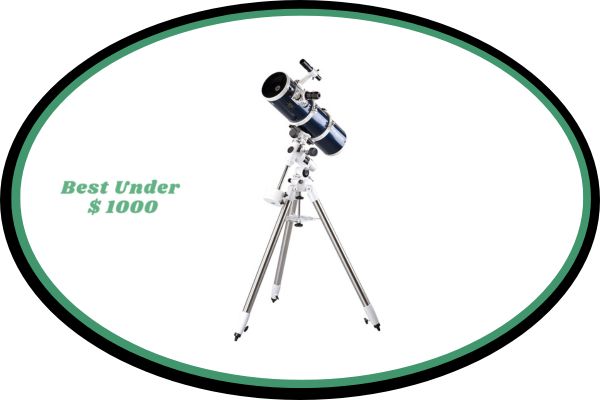
Specifications
- Type: Newtonian reflector
- Aperture: 150mm
- Focal length: 750mm
- Optics: Hand-selected glass lenses with StarBright XLT coatings
- Mount: German Equatorial Mount
- Accessories: Finderscope, steel tripod, star diagonal, eyepiece
- Bonus: Free Starry Night software
Discover the Celestron Omni XLT 150 Newtonian Reflector Telescope — a stellar choice for budget-conscious astronomy enthusiasts. Priced under $1000, this telescope seamlessly combines impressive features with affordability, making it a standout option in its category.
At the heart of the Omni XLT 150’s excellence is its unparalleled optics. Meticulously chosen by Celestron technicians, the telescope’s lenses feature only the finest optical glass. This commitment to precision results in remarkably clear and sharp views of celestial wonders. Additionally, the StarBright XLT optical coatings enhance light transmission, ensuring maximum brightness and clarity during your observations.
Navigating the night sky is a breeze with the German Equatorial Mount accompanying the Omni XLT 150. Boasting both precision and user-friendliness, this mount offers stability and easy control with its setting circles, worm gear slow-motion controls, and ball bearings on both axes. Whether you’re a novice or a seasoned astronomer, this mount facilitates smooth and accurate tracking of celestial objects, elevating your stargazing experience.
Your purchase of the Celestron Omni XLT 150 comes complete with a suite of practical accessories. These include a 6×30 optical finderscope for precise target acquisition, a robust full-height steel tripod with 1.75″ legs for stability, a 1.25″ star diagonal for comfortable viewing angles, and a 25mm multicoated eyepiece. These accessories not only enhance your observing experience but also provide convenience right out of the box.
As an enticing bonus, Celestron offers a complimentary download of Starry Night, a highly acclaimed astronomy software program. With a vast database featuring over 36,000 celestial objects and printable sky maps, this software empowers you to delve deeper into the mysteries of the night sky, enriching your astronomical knowledge.
The Celestron Omni XLT 150 Newtonian Reflector Telescope stands as a superb choice for astronomy enthusiasts seeking top-tier quality within a reasonable budget. Its exceptional optics, meticulously selected glass, and StarBright XLT coatings deliver clear and vivid views of the universe. The German Equatorial Mount ensures stability and precise tracking, while the included accessories enhance your overall observing experience. With the added advantage of the Starry Night astronomy software, this telescope offers a comprehensive tool for exploring and understanding the night sky. For an affordable telescope that refuses to compromise on quality, the Celestron Omni XLT 150 stands as a top contender, sure to leave a lasting impression.
Pros
- Clear optics with StarBright XLT coatings
- Affordable price
- Stable German Equatorial Mount
- Convenient accessories included
- Free Starry Night software download
Cons
- Manual operation
- Limited magnification
Best Telescope Under $1000
Orion 9534 ED80T CF Triplet Apochromatic Refractor Telescope
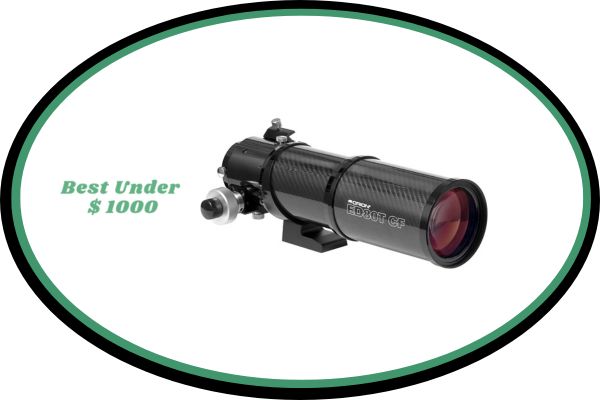
Specifications
- Type: Triplet apochromatic refractor
- Aperture: 80mm
- Focal ratio: f/6
- Optics: ED glass
- Construction: Carbon fiber tube
- Focuser: Dual-speed (11:1) 2″ Crayford focuser
- Accessories: Stepdown adapter, finder scope base, Starry Night software, carry case
Looking for a high-performance telescope under $1000? The Orion 9534 ED80T CF Triplet Apochromatic Refractor Telescope is an exceptional choice that offers versatility, superb optics, and astrophotography capabilities.
What sets this telescope apart is its advanced triplet apochromatic refractor design, featuring ED glass that ensures exceptional resolution and eliminates aberrations. Whether you’re observing celestial objects or capturing stunning astrophotographs, this telescope delivers impressive image quality. With an 80mm aperture and fast f/6 focal ratio, it excels in both visual and astrophotography applications.
Portability is key, and the Orion 9534 ED80T CF delivers. Its lightweight carbon fiber tube construction provides strength without weighing you down, making it easy to transport and ideal for stargazing on the go. Despite its compact size, the wide-field apochromatic optics produce remarkable results in astrophotography.
Included with the telescope is a robust dual-speed (11:1) 2″ Crayford focuser, allowing for precise and smooth focusing. The 2″-to-1.25″ stepdown adapter enables the use of 1.25″ eyepieces and accessories. The dovetail finder scope base simplifies the attachment of a finder scope for easy object locating.
To enhance your astronomical journey, the Orion 9534 ED80T CF comes with the Starry Night astronomy software. This valuable tool provides a wealth of information and features, expanding your understanding of the night sky. Additionally, a foam-lined hard carry case ensures safe and convenient transportation of the telescope.
The Orion 9534 ED80T CF Triplet Apochromatic Refractor Telescope is a remarkable choice for astronomy enthusiasts seeking a top-quality telescope under $1000. Its advanced optics and ED glass deliver outstanding image resolution and freedom from aberrations. The lightweight carbon fiber construction offers portability without compromising on performance. With the included accessories, such as the dual-speed focuser and dovetail finder scope base, this telescope provides convenience and versatility.
Pros
- Exceptional optics with ED glass
- Versatile for visual observing and astrophotography
- Lightweight and portable carbon fiber construction
- Precise dual-speed Crayford focuser
- Value-added accessories included
Cons
- Focal length not specified
- Limited aperture size
Best Telescope Under $1000
SVBONY SV503 Extra Low Dispersion Achromatic Refractor Telescope
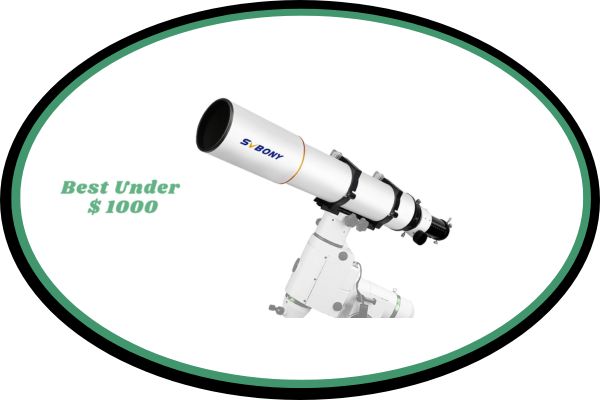
Specifications
- Objective lens diameter: 102mm
- Focal ratio: f/7
- Optics: Doublet air spaced achromatic S-FPL51 ED glass
- Coating: Ultra-wide band multi-layer coating technology
- Back focus: 90mm
- Focuser: Dual-focus rack and pinion
- Accessories: 2″ to 1.25″ adapter, metal hoop and dovetail, objective focuser wheel cover, foam-insert package
If you’re in the market for an exceptional telescope under $1000, the SVBONY SV503 Extra Low Dispersion Achromatic Refractor Telescope is a standout choice. Packed with impressive features, this telescope delivers remarkable image quality and versatility.
Featuring a large 102mm objective lens diameter and an f/7 focal ratio, the SV503 allows ample light to enter the scope, resulting in bright and clear images. The doublet air spaced achromatic S-FPL51 ED glass effectively reduces chromatic aberration, ensuring crisp and precise images.
Equipped with ultra-wide band multi-layer coating technology, this telescope produces vibrant wide-field images with sharp resolution. The 102mm aperture optics and retractable lens hood further enhance image quality, delivering immersive stargazing experiences.
A notable feature is the 90mm back focus, providing ample space for precise focusing. The telescope includes a dual-focus rack and pinion focuser with a convenient focus knob cover, making it effortless to achieve precise focus.
The package includes the 102mm refractor OTA, a 2-inch to 1.25-inch adapter for versatile accessory compatibility, a metal hoop and dovetail for secure mounting, and an objective focuser wheel cover for added protection. The telescope is thoughtfully packaged with a die-cut foam insert, ensuring safe storage and convenient transportation.
The SVBONY SV503 Extra Low Dispersion Achromatic Refractor Telescope offers remarkable value and performance for astronomy enthusiasts seeking a telescope under $1000. Its large objective lens and ED glass provide excellent image quality with minimal chromatic aberration. The telescope’s wide-field capabilities, precise focusing, and included accessories make it a versatile and user-friendly option. If you’re looking for a top-notch telescope that won’t break the bank, the SVBONY SV503 is an outstanding choice that will exceed your expectations.
Pros
- Impressive image quality with reduced chromatic aberration
- Versatile wide-field views with vibrant and sharp images
- Precise and easy focusing
- Convenient accessories included
- Safe and convenient storage and transport
Cons
- Fixed aperture size limits light-gathering capabilities
Best Telescope Under $1000
StarSense Explorer DX 130AZ Smartphone App-Enabled Telescope
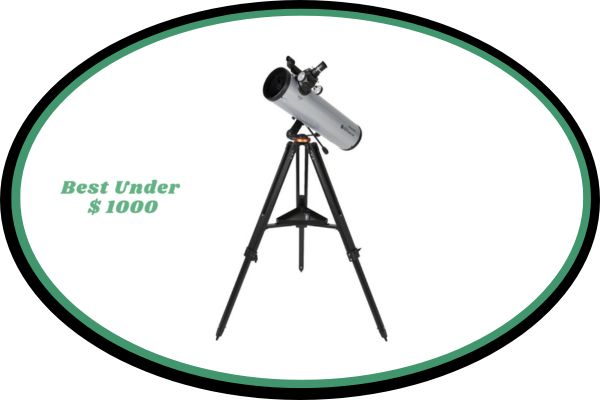
Specifications
- Smartphone Compatibility: iPhone and Android
- Sky Recognition Technology: Patented StarSense technology
- App: StarSense Explorer app
- Mount: Manual altazimuth with dual-axis controls
- Optics: 130mm Newtonian reflector
The StarSense Explorer DX 130AZ Smartphone App-Enabled Telescope is a game-changer in the world of stargazing. Designed to be accessible to all, regardless of experience level, this telescope combines the power of your smartphone with advanced technology to offer an immersive and educational celestial journey.
One standout feature of this telescope is its ability to utilize your iPhone or Android phone as a guide through the night sky. Even without prior telescope experience, simply follow the on-screen arrows on your smartphone to effortlessly locate stars, planets, and more. It’s an interactive and user-friendly approach that opens up the wonders of the cosmos to everyone.
What truly sets this telescope apart is its patented StarSense sky recognition technology. By analyzing star patterns in real time, in conjunction with your smartphone, it accurately calculates the telescope’s position. This eliminates the guesswork and allows for seamless navigation of the night sky, making stargazing a breeze.
Enhancing your experience is the StarSense Explorer app, which generates a customized list of the best celestial objects to view based on your specific time and location. Whether you’re observing from a city or a darker site, the app recommends a diverse range of targets, including planets, nebulae, galaxies, and star clusters. It’s like having a personal astronomer guiding you through the universe.
Setting up and using the telescope is a breeze thanks to its manual altazimuth mount with smooth, dual-axis slow-motion controls. Simply follow the on-screen arrows until the bullseye turns green, indicating that your desired target is ready to view through the telescope’s eyepiece.
Equipped with a high-quality 130mm Newtonian reflector, this telescope delivers impressive views. Its 5″ primary mirror, featuring highly reflective coatings, ensures clear and detailed images. From exploring lunar craters to observing Jupiter, Saturn, Mars, and captivating deep sky objects like the Orion Nebula, Andromeda Galaxy, and Pleiades Open Star Cluster, the possibilities for discovery are endless.
The StarSense Explorer DX 130AZ Smartphone App-Enabled Telescope revolutionizes stargazing with its smartphone integration, patented sky recognition technology, and user-friendly app. It offers an accessible and educational experience for all astronomy enthusiasts. With its high-quality optics and the ability to explore a multitude of celestial objects, this telescope is a standout choice for those seeking a top-notch telescope under $1000.
Pros
- Smartphone-guided stargazing
- Accurate sky recognition technology
- Personalized object recommendations via the app
- Easy setup with smooth controls
- Clear views with the 130mm reflector
Cons
- Dependence on smartphone
- Limited magnification information
Best Telescope Under $1000
Sky-Watcher StarTravel 120 Portable Refractor Telescope
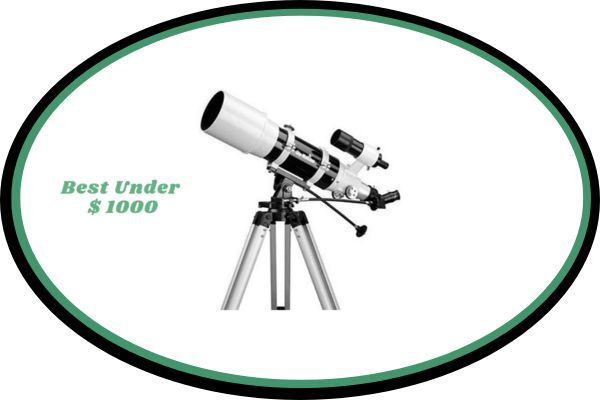
Specifications
- Telescope Type: Portable refractor telescope
- Mount Type: Sky-Watcher AZ3
- Optics: Two-element air-spaced fully multi-coated lenses
- Aperture: 120mm
- Focal Ratio: f/5
- Eyepieces: 10mm and 25mm
- Accessories: 45° erect image prism, red dot finder
- Tripod: Lightweight aluminum
Are you on the hunt for a telescope that marries power with portability? Look no further than the Sky-Watcher StarTravel 120 Portable Refractor Telescope, a top-tier choice in the world of telescopes.
A standout feature of this telescope is the seamless integration of the Sky-Watcher AZ3 mount and the StarTravel achromat refractor telescope. This combination delivers fast f/5 optics, providing exceptional high-contrast wide field views ideal for both celestial and terrestrial observations. What’s more, the entire setup weighs in at under 17 pounds, ensuring maximum portability.
The optical prowess of the StarTravel 120 is truly remarkable. It boasts two-element air-spaced fully multi-coated lenses, guaranteeing professional-grade quality. Whether you’re exploring the lunar surface, distant planets, or deep-sky wonders, this telescope will leave you awe-inspired and offers superb terrestrial viewing.
The telescope is furnished with 10mm and 25mm super eyepieces, offering flexibility for daytime and nighttime observations. Moreover, the included 45° erect image prism corrects the optical orientation typical of refractor-style telescopes, ensuring you see things the right way up.
For your convenience and stability, the telescope comes with an AZ3 aluminum Alt-Az tripod that’s both lightweight and robust. With slow-motion controls on both the vertical and horizontal axes, you’ll achieve pinpoint accuracy in your observations. The large accessory tray is perfect for storing eyepieces and other essential gear.
The Sky-Watcher StarTravel 120 AZ3 arrives as a complete package, simplifying your stargazing adventure. Inside, you’ll find the 120mm telescope, a lightweight aluminum tripod, two eyepieces, a correct-image prism, and a red dot finder. Everything you need to embark on your celestial journey is right at your fingertips.
The Sky-Watcher StarTravel 120 Portable Refractor Telescope offers a unique blend of portability, professional-grade optics, and user-friendly design. Its compact build, lightweight structure, and remarkable performance make it an exceptional choice for both astronomical and terrestrial observations. When exploring the world of telescopes under $1000, this versatile and all-inclusive package deserves your serious consideration.
Pros
- Portable and lightweight design
- High-quality optics for impressive views
- Versatile eyepieces for various observations
- Convenient setup with stable AZ3 mount
Cons
- Limited magnification information
- Additional equipment required for advanced features
Best Telescope Under $1000
Celestron – NexStar 130SLT Computerized Telescope
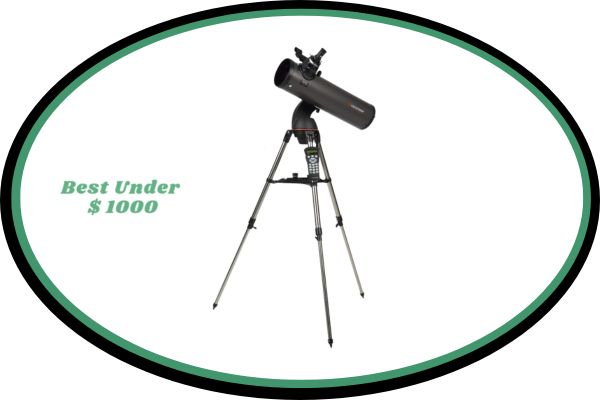
Specifications
- Computerized telescope with 40,000+ celestial object database
- 130mm aperture Newtonian reflector design
- Compact, lightweight, and portable
- Easy setup with SkyAlign procedure
- Includes free Starry Night software
The Celestron NexStar 130SLT is an extraordinary telescope that brings the wonders of the universe within reach. Its advanced features, ease of use, and impressive performance make it a standout choice for both beginners and seasoned astronomers.
One of the standout features is its computerized star locating system, which boasts a vast database of over 40,000 celestial objects. By simply selecting an object, the telescope automatically locates and tracks it, making stargazing effortless and enjoyable.
With its Newtonian reflector optical design and a sizable 130mm aperture, the NexStar 130SLT captures ample light to unveil the mysteries of our solar system and beyond. Whether it’s the intricate rings of Saturn, the mesmerizing cloud bands of Jupiter, or the detailed craters of the Moon, this telescope delivers breathtaking views.
Portability is a key advantage of the NexStar 130SLT. It is compact, lightweight, and designed for on-the-go stargazing. Whether you’re exploring your backyard, embarking on a camping trip, or venturing to a dark sky site, this telescope is your perfect companion.
Setting up the telescope is a breeze, thanks to Celestron’s SkyAlign procedure. By centering three bright objects in the eyepiece, the telescope aligns itself to the night sky, enabling you to explore a multitude of celestial objects with precision.
Celestron’s commitment to customer satisfaction is evident with their unbeatable warranty and support. When purchasing from an Authorized Dealer on Amazon, you receive a 2-Year US Warranty and access to their team of US-based experts, ensuring you have assistance whenever needed.
As a bonus, the NexStar 130SLT comes with a free download of Starry Night Special Edition astronomy software. This powerful program allows you to simulate the night sky, learn about celestial objects, and plan your observing sessions effectively.
The Celestron NexStar 130SLT Computerized Telescope is an outstanding choice for anyone seeking a remarkable stargazing experience. Its advanced features, user-friendly design, and exceptional support make it a top contender in the under $1000 telescope category. Embark on an astronomical journey with the NexStar 130SLT and explore the wonders of the universe with ease and excitement.
Pros
- Effortless object locating and tracking
- Impressive views of Saturn, Jupiter, Moon, and more
- Convenient for various locations
- Quick setup with SkyAlign
- Free astronomy software
Cons
- Limited to terrestrial objects
- Requires compatible smartphone or tablet
- Not for professional astrophotography
Best Telescope Under $1000
Orion 8945 SkyQuest XT8 Classic Dobsonian Telescope
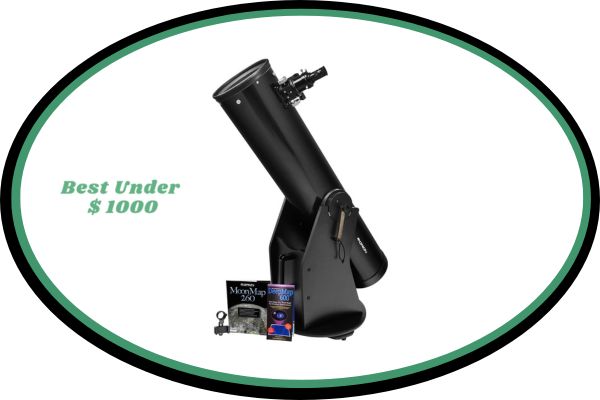
Specifications
- Aperture: 8″ reflector optics
- Versatility: Suitable for Moon, planets, nebulas, galaxies, and star clusters
- Stability: Ultra-stable Dobsonian base
- Focuser: 2″ Crayford focuser
- Accessories: 25mm eyepiece, EZ Finder II reflex sight, collimation cap, Starry Night software
The Orion 8945 SkyQuest XT8 Classic Dobsonian Telescope is a remarkable option for astronomy enthusiasts seeking a high-quality telescope without stretching your budget. With its excellent features and durability, this telescope provides an exceptional viewing experience for beginners and families alike.
One of the standout features of this telescope is its impressive 8″ diameter reflector optics. This sizable aperture allows for detailed views of the Moon and planets, while also capturing the beauty of faint nebulas, galaxies, and star clusters. The XT8’s light grasp opens up a world of celestial wonders for exploration.
Designed with user-friendliness in mind, the ultra-stable Dobsonian base ensures perfect balance, making it easy to point and view objects in the night sky. Whether you’re a novice or experienced observer, the XT8 offers a seamless and enjoyable viewing experience.
The Orion 8945 SkyQuest XT8 comes complete with a range of valuable accessories. Its 2″ Crayford focuser accommodates both 1.25″ and 2″ telescope eyepieces, providing versatility in magnification choices. Additionally, the package includes a 25mm Sirius Plossl eyepiece, an EZ Finder II reflex sight for accurate object locating, a collimation cap for precise alignment, and Starry Night software to deepen your astronomical knowledge.
With its affordability and quality construction, the Orion 8945 SkyQuest XT8 Classic Dobsonian Telescope stands out as an excellent choice in the category of best telescopes under $1000. Whether you’re a beginner or seasoned enthusiast, this telescope offers exceptional performance and lasting durability.
Embark on an exciting journey of exploration with the Orion 8945 SkyQuest XT8 Classic Dobsonian Telescope, and witness the awe-inspiring wonders of the universe from the comfort of your own backyard.
Pros
- Affordable and great value
- Detailed views with large aperture
- User-friendly for beginners and families
- Sturdy construction
Cons
- Not found
Types of Telescopes
Refractor Telescopes:
Refractor telescopes use a combination of lenses to gather and focus light. They have a straightforward design, with a long, sealed tube containing an objective lens at the front and an eyepiece at the back. The objective lens refracts (bends) the incoming light and brings it to a focal point, where the eyepiece magnifies the image for observation.
Refractor telescopes offer several advantages. Firstly, they provide high contrast and sharp images, making them ideal for observing objects such as the Moon, planets, and bright deep-sky objects. Secondly, since they don’t require frequent alignment or collimation, they are low-maintenance and durable. Additionally, refractor telescopes are well-suited for astrophotography, thanks to their excellent image quality.
However, refractors do have some limitations. They can be expensive for larger apertures due to the cost of high-quality lenses. Additionally, they may suffer from chromatic aberration, which is the dispersion of light into its component colors, resulting in color fringing around objects. This issue can be mitigated through the use of apochromatic refractors, which use special lenses to correct chromatic aberration.
Also Read: Best Binoculars For Crystal Clear Vision
Reflecting Telescopes:
Reflecting telescopes, also known as reflectors or Newtonian telescopes, use mirrors instead of lenses to gather and focus light. These telescopes consist of a primary mirror at the bottom of the tube that reflects light to a secondary mirror near the top, which then directs the light to the eyepiece for observation.
Reflecting telescopes offer several advantages. They provide larger apertures at a more affordable price compared to refractors, making them a popular choice among astronomers. The use of mirrors also eliminates chromatic aberration, resulting in sharper and more color-accurate images. Reflectors are particularly effective for observing deep-sky objects such as galaxies, nebulae, and star clusters.
However, reflector telescopes require occasional collimation, which involves aligning the mirrors to ensure optimal performance. They also tend to be bulkier and may require more maintenance compared to refractors. Additionally, the presence of a secondary mirror can create obstructions in the light path, leading to a small loss of contrast.
Compound Telescopes:
Compound telescopes, such as Schmidt-Cassegrain and Maksutov-Cassegrain telescopes, combine lenses and mirrors to achieve a compact and versatile design. They feature a corrector plate at the front that acts as a lens, a primary mirror at the back, and a secondary mirror that reflects light through a hole in the primary mirror to the eyepiece.
Compound telescopes offer several advantages. They provide long focal lengths in a compact tube, making them highly portable and convenient for both visual observations and astrophotography. They offer excellent image quality, making them suitable for observing both planets and deep-sky objects. Compound telescopes also have a wide field of view, allowing for immersive observations.
However, compound telescopes tend to be more expensive compared to refractors or reflectors of similar aperture sizes. They may also have a narrower field of view compared to refractors. Additionally, their complex design can result in a longer setup time and potentially higher maintenance requirements.
Also Read: Best Night Vision Scope For Hunters
Features to Look in Best Telescopes Under $1000
When searching for the best telescopes under a budget of $1000, it is important to consider specific features that will ensure a satisfying and immersive stargazing experience. Here are some key features to look for when choosing a telescope within this price range:
Aperture:
The aperture of a telescope refers to the diameter of its primary lens or mirror. It is one of the most critical factors in determining a telescope’s light-gathering capability and image quality. Telescopes with larger apertures can collect more light, resulting in brighter and more detailed views of celestial objects. In the $1000 price range, you can find telescopes with apertures ranging from 4 inches (100mm) to 8 inches (200mm) or even larger. Consider your observing goals and the types of objects you wish to observe when selecting the appropriate aperture size.
Optical Quality:
The optical quality of a telescope plays a significant role in the sharpness and clarity of the images it produces. Look for telescopes with high-quality lenses or mirrors made from materials such as high-grade glass or precision-ground mirrors. Advanced optical coatings, such as multi-coatings or anti-reflective coatings, can reduce reflections and enhance contrast, resulting in improved image quality. It is important to research reputable manufacturers and read reviews to ensure that you are selecting a telescope with excellent optical performance.
Also Read: Top Wooden Swing Set Under 1000
Mount Type:
Telescopes come with different mount types, and each offers its own advantages. Altazimuth mounts provide simple up-and-down and left-to-right movement, making them easier to use, particularly for beginners. Equatorial mounts, on the other hand, are designed to align with the Earth’s axis, allowing for precise tracking of celestial objects as they appear to move across the sky. Equatorial mounts are particularly useful for astrophotography and prolonged observations. Consider your level of experience, observing goals, and whether you prioritize convenience or precise object tracking when selecting the mount type.
Focal Length and Ratio:
The focal length of a telescope determines the magnification and field of view it provides. Telescopes with longer focal lengths offer higher magnification, making them suitable for detailed observations of planets and smaller celestial objects. However, they typically have narrower fields of view. Telescopes with shorter focal lengths provide wider fields of view, making them ideal for observing larger celestial objects such as galaxies and nebulae. Consider your interests and whether you prefer higher magnification or a broader view when choosing the focal length and ratio of a telescope.
Portability:
Portability is an important consideration, especially if you plan to take your telescope on the go or travel to different observation locations. Telescopes vary in size and weight, so look for models that are lightweight and easy to assemble and disassemble. Compact designs are more convenient for transportation and storage. Additionally, telescopes that come with carrying cases or handles can facilitate their portability.
Also Read: Best Value Synthesizers Under 1000
Ease of Use:
Consider telescopes that are user-friendly, especially if you are a beginner or value convenience. Look for telescopes that offer easy alignment procedures, intuitive controls, and clear instructions. Some telescopes come with computerized or motorized systems that can automatically align and track celestial objects, simplifying the observing process. Consider telescopes with features that make setup and operation hassle-free, allowing you to focus more on enjoying the views.
Durability and Build Quality:
A telescope is an investment, so you want to ensure that it is built to last. Look for telescopes made with sturdy materials such as aluminum or steel. Check for solid construction and components that can withstand regular use and potential transportation. It is also worth considering telescopes with weather-resistant features if you plan to observe in different weather conditions. Reading customer reviews and considering the reputation of the manufacturer can provide insights into the durability and build quality of different telescope models.
Accessories:
Accessories can enhance your observing experience and expand the capabilities of your telescope. Consider telescopes that come with quality eyepieces, as they greatly impact the clarity and magnification of the views. Finderscopes or red dot finders assist in locating celestial objects. Tripods should provide stability and support for the telescope. Some telescopes may include additional accessories like Barlow lenses (which increase magnification), filters (for enhancing views of specific objects or reducing light pollution), or smartphone adapters (for astrophotography). Assess the included accessories and their quality to determine their value and usefulness to you.
Also Read: Best Budget Headphones Under $1000
Value for Money:
It is important to evaluate the overall value offered by a telescope within your budget. Compare the features, performance, and included accessories of different models. Read customer reviews and seek recommendations from trusted sources to gauge the satisfaction of other users. Consider the balance between the price and the quality of the telescope to ensure that you are getting the best value for your investment.
Brand Reputation:
Consider telescopes from reputable brands known for their quality products and customer support. Established brands often have a track record of producing reliable telescopes and providing good customer service. They may also offer better warranties and a wider range of compatible accessories. Research the reputation of different brands and consider their standing within the astronomy community.
FAQs Best Telescopes Under $1000
What can I expect from a telescope under $1000?
Telescopes priced under $1000 offer a range of features and capabilities suitable for astronomy enthusiasts. With this budget, you can expect to find telescopes with decent aperture sizes, typically ranging from 4 inches (100mm) to 8 inches (200mm). These apertures are adequate for observing celestial objects such as the Moon, planets, and various deep-sky objects like galaxies, nebulae, and star clusters. While you may not have the largest aperture available, telescopes under $1000 can still provide satisfying views of the night sky.
Also Read: High Quality Microphones Under $1000
Can I use a telescope under $1000 for astrophotography?
Yes, it is possible to engage in astrophotography with a telescope under $1000. However, keep in mind that the capabilities for astrophotography may vary depending on the specific model and brand. Look for telescopes with features that support astrophotography, such as sturdy mounts, precise tracking systems, and the ability to attach cameras. Refractor telescopes and some compound telescopes, like Schmidt-Cassegrains, are popular choices for astrophotography within this price range.
What should I prioritize when choosing a telescope under $1000: aperture size or advanced features?
When selecting a telescope under $1000, it’s important to consider your observing priorities. Aperture size plays a crucial role in the brightness and level of detail you can see. So, if your primary focus is on observing celestial objects with greater clarity, it’s advisable to prioritize larger aperture sizes. However, if you value convenience and advanced features such as computerized Go-To functionality, you may need to compromise on aperture size within your budget.
Are there any specific brands known for producing quality telescopes under $1000?
Several reputable brands offer quality telescopes under $1000. Some well-regarded options include Celestron, Orion, Meade, and Sky-Watcher. These brands have a wide selection of telescopes in various configurations, including refractors, reflectors, compound telescopes, and Dobsonians. It’s recommended to research specific models within your preferred brand and read customer reviews to ensure they meet your requirements.
Also Read: Best Basketball Hoops Under $1000
Can I observe deep-sky objects with a telescope under $1000?
Yes, telescopes under $1000 can provide satisfying views of deep-sky objects. While larger aperture telescopes generally offer better performance for observing these objects, even telescopes with smaller apertures can reveal notable details. Reflecting telescopes, such as Newtonians or Dobsonians, are particularly suitable for observing deep-sky objects due to their light-gathering capabilities. However, it’s important to manage your expectations and consider factors like light pollution and observing conditions, which can affect the visibility of deep-sky objects.
What additional accessories should I consider for my telescope under $1000?
Depending on the specific telescope model, there are several accessories worth considering. Quality eyepieces are essential for different magnification options and comfortable viewing. Finderscopes or red dot finders help with locating objects in the sky. Filters can enhance views by reducing light pollution or enhancing specific wavelengths. Additionally, smartphone adapters allow you to capture images using your smartphone through the telescope. Assess the included accessories and determine which ones align with your observing goals and budget.
What warranty coverage can I expect for telescopes under $1000?
Warranty coverage for telescopes under $1000 can vary depending on the manufacturer and model. Reputable brands often offer warranties ranging from one to five years for their telescopes. It’s essential to check the warranty information provided by the manufacturer before making a purchase to ensure you understand the coverage and any conditions that may apply.
Also Read: Best DJ Controllers for Exceptional Mixing
Conclusion
In conclusion, when it comes to selecting the best telescope under $1000, it is important to consider various factors and make an informed decision. Understanding the different types of telescopes available, such as refractors, reflectors, compound telescopes, Dobsonians, and catadioptric telescopes, allows you to choose the one that suits your needs and preferences.
Refractor telescopes, known for their sharp and high-contrast images, are ideal for observing the Moon, planets, and bright deep-sky objects. Reflectors offer larger apertures at a more affordable price, making them great for deep-sky observations. Compound telescopes provide a balance between portability and performance, while Dobsonians offer simplicity and “light-bucket” capabilities. Catadioptric telescopes combine lenses and mirrors, providing versatility for various types of observations.
Consider your specific interests, whether it’s astrophotography, planetary observations, or exploring deep-sky objects. Depending on your priorities, you may need to decide between aperture size and advanced features like Go-To functionality.
Research reputable brands like Celestron, Orion, Meade, and Sky-Watcher, as they offer quality telescopes under $1000. Reading customer reviews and seeking advice from experienced astronomers can provide valuable insights.
Also Read: The Luxury Designer Handbags Under $1000
In addition, consider accessories such as eyepieces, finderscopes, filters, and smartphone adapters to enhance your observing experience. Understanding the warranty coverage offered by the manufacturer is also important to protect your investment.
Remember, this guide serves as a starting point in your search for the best telescope under $1000. It is crucial to conduct thorough research, gather information, and make a decision based on your individual requirements. With the right telescope, you can embark on a fascinating journey exploring the wonders of the night sky and enjoy countless hours of stargazing pleasure.
